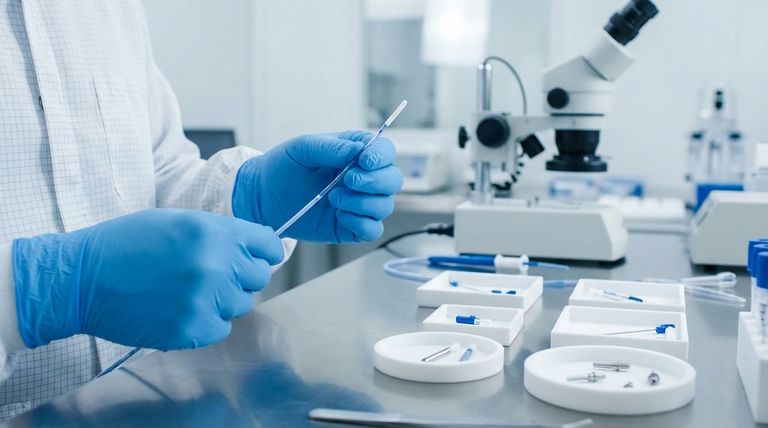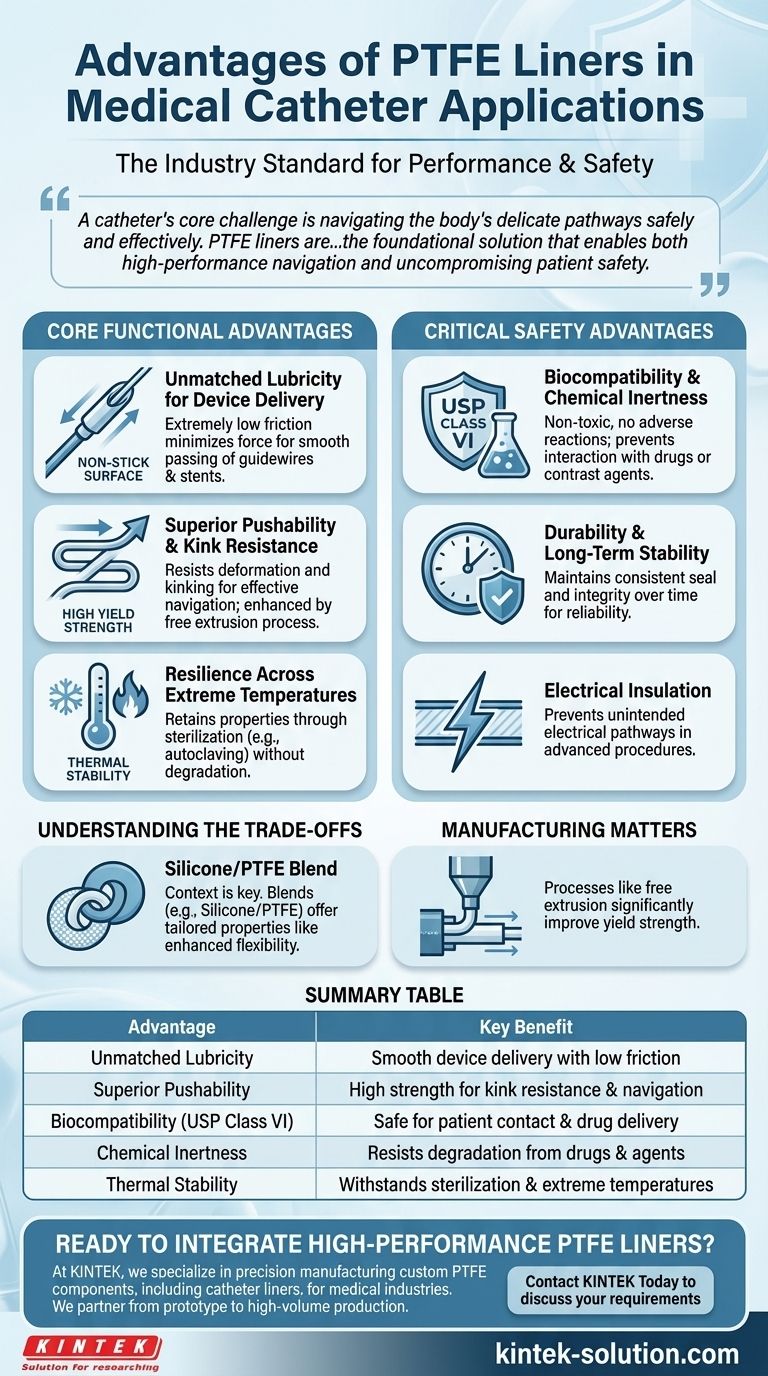In medical catheter design, Polytetrafluoroethylene (PTFE) liners are the industry standard due to a unique combination of properties. They provide an exceptionally low-friction surface for smooth device delivery, high yield strength for pushability and kink resistance, and are chemically inert and biocompatible, ensuring patient safety.
A catheter's core challenge is navigating the body's delicate pathways safely and effectively. PTFE liners are not just a component choice; they are the foundational solution that enables both high-performance navigation and uncompromising patient safety.

The Core Functional Advantages
The performance of a catheter during a medical procedure is largely dictated by the properties of its innermost layer. PTFE provides distinct mechanical benefits that are critical for success.
Unmatched Lubricity for Device Delivery
PTFE possesses an extremely low coefficient of friction, creating an inherently non-stick surface.
This property is crucial for minimizing the force required to pass instruments like guidewires, stents, or other devices through the catheter, ensuring smooth and precise delivery to the target site.
Superior Pushability and Kink Resistance
Catheters must be flexible enough to navigate tortuous anatomy but rigid enough to transmit force from the operator's hand to the distal tip. This is known as pushability.
PTFE has a high yield strength, meaning it resists deformation and kinking under the compressive and bending forces experienced during a procedure. Manufacturing techniques like the free extrusion process can further enhance this strength, improving device reliability.
Resilience Across Extreme Temperatures
PTFE retains its exceptional physical properties across a very wide temperature range.
This thermal stability ensures the liner remains functional during medical procedures and can withstand common sterilization methods, such as autoclaving, without degrading.
The Critical Safety Advantages
Beyond mechanical performance, the choice of a liner material has direct implications for patient safety and the integrity of the delivered therapy.
Biocompatibility and Chemical Inertness
PTFE is classified as a USP Class VI material, the highest standard for biocompatibility, indicating it is non-toxic and causes no adverse reactions when in contact with human tissue or bodily fluids.
Furthermore, its chemical inertness means it will not react with or degrade the various drugs or contrast agents that are often delivered through the catheter, preserving the integrity of the therapy.
Durability and Long-Term Stability
The combination of PTFE's chemical resistance and physical resilience makes it highly durable.
This ensures the liner maintains a consistent, reliable seal and will not break down over time, a critical factor for both single-use devices and implantable systems.
Electrical Insulation
In certain advanced procedures, such as those involving conductive fluids or electrophysiology, PTFE’s properties as an electrical insulator provide an additional layer of safety. This helps prevent unintended electrical pathways, enhancing the overall safety of the system.
Understanding the Trade-offs
While PTFE is the benchmark for catheter liners, no single material is perfect for every application. Understanding its context is key to optimal design.
Material Selection is Context-Dependent
For applications requiring extreme flexibility, a pure PTFE liner might be blended with other materials.
For example, a Silicone/PTFE liner combines the lubricity and inertness of PTFE with the enhanced flexibility and resilience of silicone. This demonstrates that design often involves tailoring materials to specific procedural demands.
Manufacturing Processes Matter
The performance of a PTFE liner is not solely dependent on the raw material.
As noted, the free extrusion process can significantly improve yield strength. This highlights that the manufacturing method is just as critical as material selection for achieving the desired performance characteristics.
Making the Right Choice for Your Application
Selecting the right liner material requires aligning its properties with your primary design goal.
- If your primary focus is smooth device delivery: PTFE's unmatched lubricity and non-stick surface is the most critical advantage for reducing friction.
- If your primary focus is navigating complex anatomy: PTFE's unique balance of high yield strength and flexibility ensures superior pushability and kink resistance.
- If your primary focus is patient safety: PTFE's USP Class VI biocompatibility and chemical inertness provide a non-negotiable foundation of safety.
Ultimately, choosing a PTFE liner provides your medical device with a proven foundation of performance, reliability, and safety.
Summary Table:
| Advantage | Key Benefit |
|---|---|
| Unmatched Lubricity | Smooth device delivery with low friction |
| Superior Pushability | High strength for kink resistance & navigation |
| Biocompatibility (USP Class VI) | Safe for patient contact & drug delivery |
| Chemical Inertness | Resists degradation from drugs & agents |
| Thermal Stability | Withstands sterilization & extreme temperatures |
Ready to integrate high-performance PTFE liners into your medical device?
At KINTEK, we specialize in the precision manufacturing of custom PTFE components, including catheter liners, for the medical, semiconductor, and laboratory industries. Our expertise ensures your device benefits from the superior lubricity, strength, and biocompatibility that PTFE provides.
We partner with you from prototype to high-volume production, delivering components that meet the highest standards of safety and reliability.
Contact KINTEK today to discuss your specific requirements and elevate your catheter design.
Visual Guide

Related Products
- Custom PTFE Parts Manufacturer for Teflon Containers and Components
- Custom PTFE Parts Manufacturer for Teflon Parts and PTFE Tweezers
- Custom PTFE Sleeves and Hollow Rods for Advanced Applications
- Custom PTFE Measuring Cylinders for Advanced Scientific and Industrial Applications
- Custom PTFE Bottles for Diverse Industrial Applications
People Also Ask
- Why is dimensional stability a concern when machining PTFE? Ensure Accurate, Stable PTFE Components
- Why is PTFE considered a significant discovery? A Material That Revolutionized Industry
- What is the temperature range that PTFE can withstand? From -200°C to +260°C for Demanding Applications
- What is the working temperature range of PTFE? Master Extreme Heat and Cryogenic Applications
- How is PTFE used in industrial processes? Maximize Safety and Efficiency



















